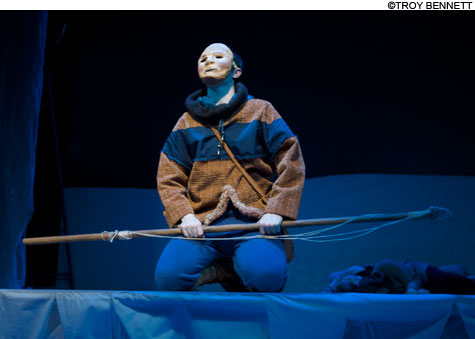
IN SEARCH OF THE SUN Sage Landry as Inook, with a mask by Monica Morrison.
|
Many of us here in Maine are guilty of having at one time or another harangued the forces of spring to hurry it up already, are guilty of cold-month mopery or worse. Imagine, then, living in the Arctic, where the winter is far darker for far longer, and the sun that much more precious. It’s in this extreme and archetypal setting that one cold and hungry young Inuit man does more than just offhandedly harangue the elements — he strides off to forcibly take the sun back all by himself.
Thus the quest at the heart of Henry Beissel’s Inook and the Sun, a mythic journey in which young Inook (Sage Landry), representing humanity writ large, first struggles against nature, then comes to accept that he is not, after all, at its center. Director Assunta Kent’s elaborate production of this simple, primal tale, by the University of Southern Maine’s Department of Theatre, includes, among other things, multi-media shadow-puppetry, an eight-person-manned Sea Monster, and Moon and Wind spirits (Ryan Nash and Simon Skold) climbing on suspended cables.
A composer and a slew of designers — particularly those overseeing scenic, costume, lighting, sound, and puppet design — have been very busy in crafting for this show: Set designer Perry Fertig has created a vast sheathing of white over the proscenium and lower thrust, with pale folds of fabric nicely evoking snowdrift; on his journey Inook encounters several strikingly devised characters: Sea goddess Sedna (Desiray Roy) is wrapped in netting and bits of sea detritus; a fabulous gaping polar bear is three actors wide; the musk ox’s big snout (made to flap by the puppeteer Hunter Jandreau’s arms) is shaggy with fringe (animals were designed by Travis Grant). The massive Sea Monster (designed by Hannah Brown) is on wheels and sports six long tentacles, each manned in sibilant fashion by a puppeteer clear across the stage (a great and extravagant conception, though shorter lengths might have allowed for fuller undulations; as it is, it’s only the very end of the tentacles that get the most visible play).
Music and sound range from synthesized strings and whale-ish sounding underwater dissonance to Jim Alberty’s wide-ranging compositions — on the one end, the native-influenced drums and chanting of Inook; on the other, the sweet Andrews Sisters harmonies of the giggling girl-seals (Katelyn Smith, Ashley Rood, and Laura Collard).
If the scope of influences sometimes makes the show feel diffuse, it also lets it hit a little closer to our mashed-up modern sensibility. Overall, however, I often found myself most drawn to the simplest design elements — the stiff white folds of fabric catching or illuminated from within by Shannon Zura’s fine and varied lighting (her clear glacial blues are lovely); the stark and playful shadow-puppets of Inook against a pure white rectangle of projected light (by August Delisle); Inook’s rough and expressionless mask (by Monica Morrison).